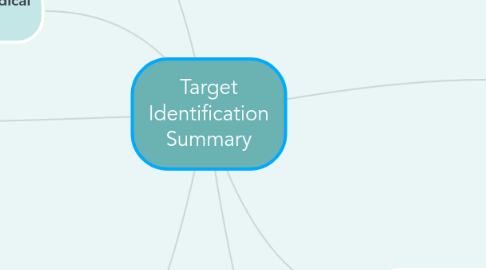Target Identification Summary
por Eunice Chow


1. Process of identifying the direct molecular target
1.1. E.g Protein or Nucleic acid
1.2. or other Small molecules
2. Early stages of drug discovery start with initial steps of target identification.
2.1. Identifying the function of a possible therapeutic target (gene/protein) and its role in the disease.
2.1.1. Efficacious, safe, meet clinical and commercial requirements.
3. Use in clinical pharmacology
3.1. Aimed at finding the efficacy target of a drug/other xenobiotic.
4. Identification of unmet medical need
4.1. Market analysis
4.2. Input from KOLs
4.3. Practitioners in Industry
5. Requires physiological and pathological understanding
5.1. "Physiological"
5.1.1. Normal Process
5.2. "Pathological"
5.2.1. Abnormal Process / Disease State
5.2.1.1. Fever
5.2.1.2. Homeostatic processes
6. New scientific approaches used to determine targets
6.1. "Targets"
6.1.1. Microorganisms, virus, genes, enzymes
6.1.1.1. The target is easily analyzable
6.1.1.2. The target possesses a promising toxicity profile, potential adverse effects can be predicted using data.
6.1.1.3. The target’s 3D-structure is available to assess druggability.
6.2. Computer modellling
6.2.1. To understand drug-target interaction
6.3. Molecule Remodelling
6.3.1. Generate and manipulate physiochemical properties
7. Approaches
7.1. Data mining with bioinformatics
7.1.1. Used to identify, select and prioritize targets.
7.2. Genetic association
7.2.1. Genetic polymorphism and connection with the disease
7.3. Expression profile
7.3.1. Measures mRNA levels, shows pattern of genes at transcription level
